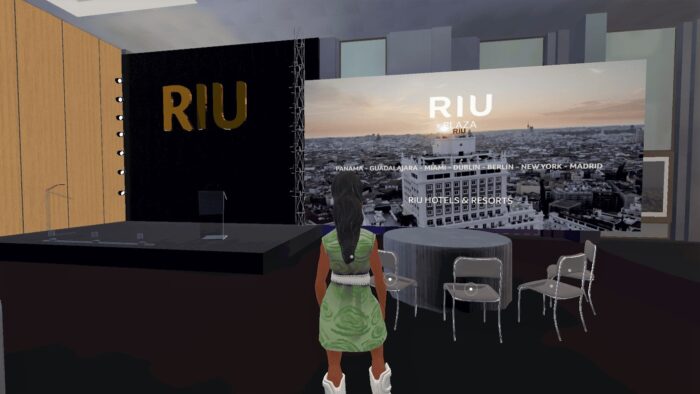All about the spatial web: questions and answers to understand it better
4 April, 2024With the launch of the Meta Quest 3 and Apple Vision Pro earlier this year, the spatial web is once again a hot topic attracting the attention of many people. From technology enthusiasts to entrepreneurs and curious onlookers in general, immersive or mixed reality experiences offer a virtual universe full of possibilities for everyone. But what exactly is the spatial web? How can you access it? Is it safe? We are going to answer these and many more questions so that you can fully understand everything that surrounds this exciting concept.
1. What is the spatial web and when was it created?
The spatial web is a three-dimensional virtual environment that allows users to interact with each other, with digital objects and with their entire environment. It is a kind of online parallel universe where reality and imagination merge.
Virtual worlds have been appearing in science fiction novels since the 1980s. It was not until 2003, however, with the creation of Second Life , when those stories became more tangible. This video game or virtual experience gave the user the ability to create 3D worlds where avatars could interact and exchange virtual goods. 2006 saw the launch of Roblox , an incredibly famous virtual space generated by blocks that, according to the company itself, has more than 70.2 million players every day. In 2012, the virtual reality glasses Oculus were launched, the first to be affordable for the masses. Just two years later, in 2014, Facebook decided to buy the company after seeing its enormous potential. In 2017, it was the turn of Fortnite. Epic Games launched one of the most successful video games in history, partnering with numerous popular franchises, including movies, television series, musicians and renowned brands, to make crossovers and in-game events.
The next stage of this universe came in 2021, when Facebook was renamed Meta, in a clear strategic move to position itself in the sector and Microsoft launched the Mesh platform. Currently the spatial web market is divided into several portions and is more accessible than ever.
2. What roles do virtual, mixed and augmented reality play in the spatial web?
Virtual, mixed and augmented reality are technologies that provide an immersive experience within the spatial web and this is the persistent space where multiple users can interact, create content and participate in various activities. An easy to understand example would be to think of an amusement park. Virtual, mixed or augmented reality would be like riding a roller coaster inside a special room with glasses that make you feel as if you were really on the roller coaster. On the other hand, the spatial web would be like having your own online park, where you can invite your friends to play with you from anywhere in the world.
3. Who is developing the spatial web?
Currently the companies that are investing the most technologically in the spatial web are Meta (formerly known as Facebook), Microsoft, Epic Games (creators of Fortnite), Roblox Corporation and Apple, along with open source communities.
4. How will the spatial web impact the hotel industry?
The spatial web offers the hospitality industry the opportunity to create immersive guest experiences, promote tourism destinations and host virtual events, which can help improve visibility and attract more guests.
For professionals in the sector, it can be a very useful tool when presenting the characteristics of their product to their potential clients. And from the perspective of the traveller or client, it is a unique opportunity. There are many destinations and companies that have opted for this technology to boost their businesses, as recently explained in this article.
5. Is special equipment needed to access the spatial web?
The short answer is no. Although virtual or mixed reality devices offer a more immersive experience and are recommended, most spatial web platforms are accessible from conventional devices such as computers or smartphones connected to the Internet. So don’t worry if you don’t have this type of headset. The virtual twin of the Riu Plaza España hotel can be tested using any device and without the need to register, thanks to the Spatial platform.

6. What activities can be carried out on the spatial web?
The possibilities of the spatial web are endless, from socialising with friends to exploring digital worlds, creating content and engaging in e-commerce. Creativity is the only limit. If you don’t know where to start, we suggest you go to Spatial and browse through all the experiences it has, you are bound to discover interesting things!
7. Is the spatial web secure?
Security on the spatial web depends on factors like the platform used and the precautions taken by users. We suggest you follow the same guidelines already recommended when using any technology, such as not sharing your personal information to avoid possible risks and making sure to use trusted platforms and apps.
8. What is the future of the spatial web?
The future of the spatial web is very exciting and promising. It is expected to keep growing and evolving, transforming the way we interact and entertain ourselves online. At RIU you already know that we are very happy to be able to do our bit through our project for the Riu Plaza España’s virtual twin, an immersive experience that offers us many opportunities.
9. But… is anyone investing in the spatial web?
Although it may seem like an incipient technology, immersive experiences are the order of the day in Spanish companies. According to a recent study carried out by Sortlist, 23.95% of Spanish companies have begun to invest in experiences for Apple’s recently launched Vision Pro and 55.09% are thinking about doing so.
We hope these answers have answered your questions about the spatial web! If you have any more questions, feel free to ask them in the comments!


